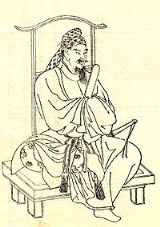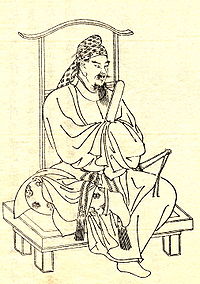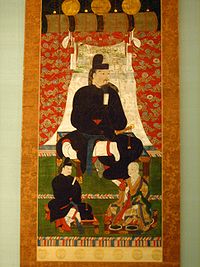
Fujiwara no Kamatari
Encyclopedia

Japanese people
The are an ethnic group originating in the Japanese archipelago and are the predominant ethnic group of Japan. Worldwide, approximately 130 million people are of Japanese descent; of these, approximately 127 million are residents of Japan. People of Japanese ancestry who live in other countries...
statesman, courtier and politician during the Asuka period
Asuka period
The , was a period in the history of Japan lasting from 538 to 710 , although its beginning could be said to overlap with the preceding Kofun period...
.
Kamatari was the founder of the Fujiwara clan in Japan. His birth clan was the Nakatomi
Nakatomi clan
The Nakatomi clan was an influential clan in Classical Japan. Along with the Inbe clan, the Nakatomi were one of two priestly clans which oversaw certain important national rites, and one of many to claim descent from divine clan ancestors "only a degree less sublime than the imperial ancestors"...
. He was the son of Nakatomi no Mikeko, and his birth name was Nakatomi no Kamatari (中臣 鎌足). Just before his death, he received the surname Fujiwara from Emperor Tenji
Emperor Tenji
, also known as Emperor Tenchi, was the 38th emperor of Japan, according to the traditional order of succession.Tenji's reign spanned the years from 661 through 671.-Traditional narrative:...
.
He was a friend and supporter of the Prince Naka no Ōe, later Emperor Tenji
Emperor Tenji
, also known as Emperor Tenchi, was the 38th emperor of Japan, according to the traditional order of succession.Tenji's reign spanned the years from 661 through 671.-Traditional narrative:...
. Kamatari was the head of the Jingi no Haku, or Shinto
Shinto
or Shintoism, also kami-no-michi, is the indigenous spirituality of Japan and the Japanese people. It is a set of practices, to be carried out diligently, to establish a connection between present day Japan and its ancient past. Shinto practices were first recorded and codified in the written...
ritualists; as such, he was one of the chief opponents of the increasing power and prevalence of Buddhism
Buddhism
Buddhism is a religion and philosophy encompassing a variety of traditions, beliefs and practices, largely based on teachings attributed to Siddhartha Gautama, commonly known as the Buddha . The Buddha lived and taught in the northeastern Indian subcontinent some time between the 6th and 4th...
in the court, and in the nation. As a result, in 645, Prince Naka no Ōe and Kamatari made a coup d'état
Coup d'état
A coup d'état state, literally: strike/blow of state)—also known as a coup, putsch, and overthrow—is the sudden, extrajudicial deposition of a government, usually by a small group of the existing state establishment—typically the military—to replace the deposed government with another body; either...
in the court. They slew Soga no Iruka
Soga no Iruka
was a statesman in the Asuka Period of Japan.He was a son of Soga no Emishi. He was assassinated by Prince Naka-no-Ōe though he tried to murder Prince Yamashiro, and to rule the emperor family. Emishi also committed suicide soon after his son's death, and the main branch of the Soga clan went...
who had a strong influence over Empress Kōgyoku
Empress Kogyoku
, also known as , was the 35th and 37th emperor of Japan, according to the traditional order of succession.Kōgyoku's reign spanned the years from 642-645. Her reign as Saimei encompassed 655-661...
; thereafter, Iruka's father, Soga no Emishi
Soga no Emishi
was a statesman of the Yamato Imperial Court. His alternative names include Emishi and Toyora no Ooomi . After the death of his father Soga no Umako, Emishi took over Ooomi, the Minister of state, from his father....
, committed suicide.
Empress Kōgyoku was forced to abdicate in favor of her younger brother, who became Emperor Kōtoku
Emperor Kotoku
was the 36th emperor of Japan, according to the traditional order of succession.The years of his reign lasted from 645 through 654.-Traditional narrative:Before Kōtoku ascension to the Chrysanthemum Throne, his personal name was or...
; Kōtoku then appointed Kamatari naidaijin (Inner Minister).
Kamatari was a leader in the development of what became known as the Taika Reforms, a major set of reforms based on Chinese models and aimed at strengthening Imperial power. He one of the principle editors responsible for the development of the Japanese legal code known as Sandai-kyaku-shiki, sometimes referred to as the Rules and Regulations of the Three Generations.
During his life Kamatari continued to support Prince Naka no Ōe, who became Emperor Tenji in 661. Tenji granted him the highest rank Taishokan and a new clan name, Fujiwara, as honors.
His son was Fujiwara no Fuhito
Fujiwara no Fuhito
Fujiwara no Fuhito was a powerful member of the imperial court of Japan during the Asuka and Nara periods...
(or Fubito). Kamatari's nephew, Nakatomi no Omimaro became head of Ise Shrine
Ise Shrine
is a Shinto shrine dedicated to goddess Amaterasu-ōmikami, located in the city of Ise in Mie prefecture, Japan. Officially known simply as , Ise Jingū is in fact a shrine complex composed of a large number of Shinto shrines centered on two main shrines, and ....
, and passed down the Nakatomi name.
Three unifiers of Japan were related to the Fujiwara:
- Oda NobunagaOda Nobunagawas the initiator of the unification of Japan under the shogunate in the late 16th century, which ruled Japan until the Meiji Restoration in 1868. He was also a major daimyo during the Sengoku period of Japanese history. His opus was continued, completed and finalized by his successors Toyotomi...
's great-grand niece married into the Fujiwara. - Toyotomi HideyoshiToyotomi Hideyoshiwas a daimyo warrior, general and politician of the Sengoku period. He unified the political factions of Japan. He succeeded his former liege lord, Oda Nobunaga, and brought an end to the Sengoku period. The period of his rule is often called the Momoyama period, named after Hideyoshi's castle...
's second wife was distantly related by marriage to the Fujiwara. - Tokugawa IeyasuTokugawa Ieyasuwas the founder and first shogun of the Tokugawa shogunate of Japan , which ruled from the Battle of Sekigahara in 1600 until the Meiji Restoration in 1868. Ieyasu seized power in 1600, received appointment as shogun in 1603, abdicated from office in 1605, but...
's heirs married into the Fujiwara.

Fumimaro Konoe
Prince was a politician in the Empire of Japan who served as the 34th, 38th and 39th Prime Minister of Japan and founder/leader of the Taisei Yokusankai.- Early life :...
the 34th/38th/39th Prime Minister of Japan and Konoe's grandson Morihiro Hosokawa
Morihiro Hosokawa
is a Japanese politician who was the 79th Prime Minister of Japan from August 9, 1993 to April 28, 1994. His coalition was the first non-Liberal Democratic Party government since 1955.- Early life :...
the 79th Prime Minister of Japan and is also a descendant of the Hosokawa clan
Hosokawa clan
The ' was a Japanese samurai clan, descended from Emperor Seiwa and a branch of the Minamoto clan, by the Ashikaga clan. It produced many prominent officials in the Ashikaga shogunate's administration. In the Edo period, the Hosokawa clan was one of the largest landholding daimyo families in Japan...
via the Ashikaga clan
Ashikaga clan
The ' was a prominent Japanese samurai clan which established the Muromachi shogunate and ruled Japan from roughly 1336 to 1573.The Ashikaga were descended from a branch of the Minamoto clan, deriving originally from the town of Ashikaga in Shimotsuke province .For about a century the clan was...
of the Minamoto clan
Minamoto clan
was one of the surnames bestowed by the Emperors of Japan upon members of the imperial family who were demoted into the ranks of the nobility. The practice was most prevalent during the Heian Period , although its last occurrence was during the Sengoku Era. The Taira were another such offshoot of...
. {Tokugawa Ieyasu
Tokugawa Ieyasu
was the founder and first shogun of the Tokugawa shogunate of Japan , which ruled from the Battle of Sekigahara in 1600 until the Meiji Restoration in 1868. Ieyasu seized power in 1600, received appointment as shogun in 1603, abdicated from office in 1605, but...
first wife was also related to the Minamoto clan
Minamoto clan
was one of the surnames bestowed by the Emperors of Japan upon members of the imperial family who were demoted into the ranks of the nobility. The practice was most prevalent during the Heian Period , although its last occurrence was during the Sengoku Era. The Taira were another such offshoot of...
}.
In the 13th century, the main line of the Fujiwara family split into five houses: Konoe
Konoe family
The Konoe family is a branch of the Fujiwara clan, a powerful noble family in Japan. As one of the five regent houses, the Konoe family monopolized the offices of Sessho and Kampaku along with Takatsukasa, Kujō, Ichijō and Nijō families. They are collectively known as the Five regent houses.With...
, Takatsukasa
Takatsukasa family
The Takatsukasa family is a branch of the Fujiwara clan of Japan. In the 13th century, the main line of the Fujiwara family split into five houses: Konoe, Takatsukasa, Kujō, Nijō and Ichijō. These five families in turn provided regents for the Emperor, and were thus known as the Five Regent...
, Kujō
Kujō family
The Kujō family was a Japanese noble family and a branch of the Fujiwara clan derived from Fujiwara no Tadamichi. They were counted as one of the Sekke, the five regent houses and therefore one of the most politically powerful families among the kuge .As one of the Sekke, the five regent houses,...
, Nijō
Nijo family
The was one of five regent houses, branches of the Fujiwara clan, a powerful noble family that monopolized regent positions Sesshō and Kampaku in Japan. The family was founded by Kujō Michiie's second son Nijō Yoshizane, while his third son Ichijō Sanetsune founded Ichijō family.-External links:* ...
and Ichijō
Ichijo family
The was one of five regent houses, branches of the Fujiwara clan, a powerful noble family monopolizing regent positions Sesshō and Kampaku in Japan. The family was founded by Kujō Michiie's third son Ichijō Sanetsune....
. These five families in turn provided regents for the Emperor, and were thus known as the Five Regent Houses
Five regent houses
The Five regent houses is a collective term for those five families of Fujiwara clan, who were regarded entitled to the position of Sekkan in the Imperial Court of Kyoto, Japan, and monopolized the position between 12th and 19th century...
. The Tachibana clan (samurai) also claim descent from the Fujiwara. Emperor Montoku
Emperor Montoku
was the 55th emperor of Japan, according to the traditional order of succession.The years of Montoku's spanned the years from 850 through 858.-Traditional narrative:...
of the Taira clan
Taira clan
The was a major Japanese clan of samurai in historical Japan.In reference to Japanese history, along with Minamoto, Taira was a hereditary clan name bestowed by the emperors of the Heian Period to certain ex-members of the imperial family when they became subjects...
was descended through his mother of the Fujiwara. {Oda Nobunga also claimed descent from the Taira clan
Taira clan
The was a major Japanese clan of samurai in historical Japan.In reference to Japanese history, along with Minamoto, Taira was a hereditary clan name bestowed by the emperors of the Heian Period to certain ex-members of the imperial family when they became subjects...
}.
Until the marriage of the Crown Prince Hirohito
Hirohito
, posthumously in Japan officially called Emperor Shōwa or , was the 124th Emperor of Japan according to the traditional order, reigning from December 25, 1926, until his death in 1989. Although better known outside of Japan by his personal name Hirohito, in Japan he is now referred to...
(posthumously Emperor Shōwa) to Princess Kuni Nagako (posthumously Empress Kōjun
Empress Kojun
' was empress consort of Emperor Hirohito of Japan. Born , she was the mother of the present Emperor .Her posthumous name is Kōjun, which means "fragrant purity"...
) in January 1924, the principal consorts of emperors and crown princes had always been recruited from one of the Sekke Fujiwara. Imperial princesses were often married to Fujiwara lords - throughout a millennium at least. As recently as Emperor Shōwa's third daughter, the late former Princess Takanomiya (Kazoku), and Prince Mikasa's elder daughter, the former Princess Yasuko, married into Takatsukasa and Konoe families, respectively. Empress Shōken was a descendant of the Fujiwara clan and through Hosokawa Gracia
Hosokawa Gracia
', usually referred to as ', was a Christian convert, a daughter of Akechi Mitsuhide and the wife of Hosokawa Tadaoki....
of the Minamoto clan
Minamoto clan
was one of the surnames bestowed by the Emperors of Japan upon members of the imperial family who were demoted into the ranks of the nobility. The practice was most prevalent during the Heian Period , although its last occurrence was during the Sengoku Era. The Taira were another such offshoot of...
. Likewise a daughter of the last Tokugawa Shogun
Tokugawa Yoshinobu
was the 15th and last shogun of the Tokugawa shogunate of Japan. He was part of a movement which aimed to reform the aging shogunate, but was ultimately unsuccessful...
married a second cousin of Emperor Shōwa.

